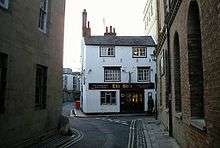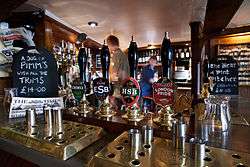Bear Inn, Oxford
The Bear Inn (or just "The Bear")[1] is one of the oldest pubs in Oxford, England, dating back to 1242.[2][3][4] Its circa-17th century incarnation stands on the corner of Alfred Street and Blue Boar Street, opposite Bear Lane in the centre of Oxford, just north of Christ Church.
| The Bear Inn | |
|---|---|
 View of The Bear from Bear Lane. | |
 Location within Central Oxford | |
| General information | |
| Address | 6 Alfred Street, Oxford, United Kingdom |
| Coordinates | 51°45′05″N 1°15′21″W |
| Opened | 1242 |
| Website | |
| bearoxford | |
History
The earliest mention of the lands and buildings subsequently occupied by The Bear Inn are found in the Cartularies of St Frideswide. Christina Pady, who was part of the ruling group of burgess families in Oxford at this time, is recorded as having inherited these properties from her late husband, Laurence Kepeharme, the first Mayor of Oxford (died circa 1209) and from her uncle, John Pady. She bequeathed in frankalmoin the land comprising two properties Parn Hall (Pirnehalle) at the western corner of High Street and Alfred Street and another to the south, on the corner of Alfred Street and Blue Boar Street, to the Priory of St Frideswide, which stood on the current site of Christ Church Cathedral. This bequest was made around 1220 to 1230, and was completed on 28 April 1241.[5] A lease dating from 1523 states that the Bear was bounded on the south by the cemetery of St Edward's Church, which lay beyond St Edward's Street (now Blue Boar Lane). It is thought that the two properties bequeathed by Christina Pady were joined and formed the yard of what became the Inn.[6]
The next mention is in the tenancy agreement of Thomas Pope in 1277, who with his wife and son were assured tenancy for the rest of their lives for a sum of two marks per year, with a deposit of 30 marks.[5] The original building burnt down in 1421.[7] In 1432, the inn was leased to John and Joan Berford, at which time it was known as Le Tabard.[8] It was known as The Bear Inn by 1457,[8] and a transfer of tenancy from Robert Mychegood to Henry Stanley took place in 1522.[8]
It was temporarily known as Furres Inn at some point. A margin note in Anthony Wood's Survey of the Antiquities of the City of Oxford (1661–66) states that the Furreses lived at the Bear in the time of Henry VIII (i.e in the first half of the 16th Century). The main text states that the inn came, under the name of The Bear Inne into the possession of brothers Richard and Roger Taverner following the dissolution of St Frideswide's Priory. Richard Edes, later Dean of Worcester, records the proprietor of The Bear in 1583 as a Matthew Harrison, who had a pet bear named Furze.[9] An alternative explanation is that it adopted the emblem of the bear and ragged staff on the crest of Richard Neville, the Earl of Warwick.
It was especially fashionable in the 17th century, when judges and royal commissioners were among the patrons. The heir to the throne in Denmark visited in 1652. When it closed in 1801, there were over thirty bedrooms, with stabling for a similar number of horses.
In the 18th century, the Bear served as the depot for the Oxford Machine coach, which carried passengers to London for a fare of 10 shillings.[7]
The present building was built in the early 17th century as the residence of the coaching inn's ostler. It was converted into a separate tavern, The Jolly Trooper, in 1774.[7] The Bear Inn's premises at the High Street was rebuilt and converted into private housing in 1801 and its business name transferred to the former Jolly Trooper.[7][10][11]
Tie collection

A distinctive feature of the Bear is a collection of over 4,500 snippets of club ties, started in 1952 by the landlord, Alan Course,[7] who has worked as cartoonist at the Oxford Mail.[12][13] Tie ends were clipped with a pair of scissors in exchange for half a pint of beer. These were originally pinned to the wall and are now displayed in glass-fronted cases on the walls and even the (low) ceiling. The ties mostly indicate membership of clubs, sports teams, schools and colleges, etc.
In popular culture
The Bear is recorded in Richard Edes's 1583 verse Iter Boreale. Edes mentions that the proprietors, Matthew and Doll Harrison had a tame pet bear named Furze.[9] Edes was a student of Christ Church and went on to become the Dean of Worcester and one of the translators of the King James Version of the Bible.
The Bear is featured in Colin Dexter's novel Death Is Now My Neighbour. Inspector Morse seeks the aid of the pub's landlords (and tie experts), Steve and Sonya Lowbridge in identifying a tie from a photograph.[14] It is also featured in the autobiography of Oxford-educated Australian arts leader Anthony Steel, who recalls Alan Course playing the Last Post on his bugle, for a student lying in the middle of the street outside the pub.[15]
Gallery
 View from Bear Lane.
View from Bear Lane. Outside tables of The Bear.
Outside tables of The Bear. The Bear's tie collection.
The Bear's tie collection. The bar at the Bear Inn.
The bar at the Bear Inn.
See also
- Bear Inn (disambiguation)
References
- Honey, Derek S. An encyclopaedia of Oxford pubs, inns and taverns. Usk: Oakwood, 1998, p. 19.
- Benedict Le Vay (1 October 2011). Ben Le Vay's Eccentric Oxford. Bradt Travel Guides. p. 249. ISBN 978-1-84162-426-6. Retrieved 27 August 2013.
- "The Bear Inn information". Let's Go. Archived from the original on 27 August 2013. Retrieved 27 August 2013.
- Pool, Krystal (5 September 1971). "Woodstock - The One Where Burtons Stayed". Toledo Blade. Google News. p. 9. Retrieved 27 August 2013.
- Wigram, Spencer Robert (1895), Cartulary of St Frideswide's, Clarendon Press
- Salter, Herbert Edward (1772), Survey of Oxford
- Hibbert, Christopher, ed. (1988). "Bear Inn". The Encyclopaedia of Oxford. Macmillan. pp. 35–36. ISBN 0-333-39917-X.
- Salter, Survey of Oxford
- Eedes, Richard (1583), Iter Borealecf. Furze with the previous name of the pub, Furres Inn
- Ingram, James (1837), Memorials of Oxford, 3, John Henry Parker, retrieved 18 February 2013
- Historic England (12 January 1954). "Bear Inn Public House (1047357)". National Heritage List for England. Retrieved 9 January 2013.
- "Alan Course, Cartoonist", Oxford Mail, 14 May 2012, retrieved 13 February 2013
- "Mail cartoonist Alan Course and friends at the piano", Oxford Mail, 12 November 2012, retrieved 13 February 2013
- Dexter, Colin (1996), Death Is Now My Neighbour, Macmillan
- Steel, Anthony (2009), Painful in Daily Doses: An Anecdotal Memoir, Wakefield Press